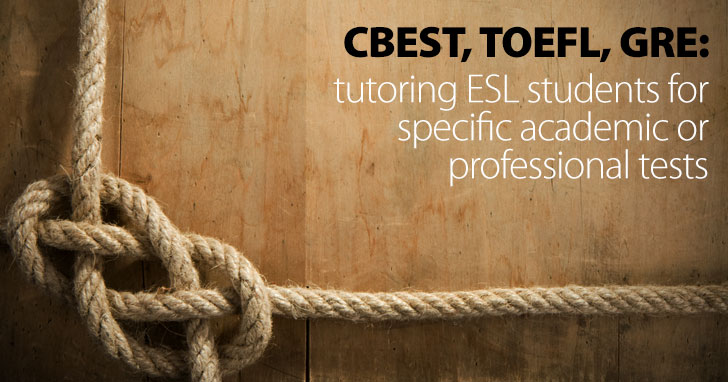The vast majority of English as a Second Language students attend class to improve conversational or academic English in general, not targeting any particular skill or content.
However, there is the occasional student who is there targeting a specific skill, such as writing, while being fluent in other skills in English.
Even less often a student approaches the instructor asking for individual tutoring in order to succeed on the GRE (Graduate Record Exam) or TOEFL (Test of English as a Foreign Language) or CBEST (California Basic Skills Test, which all educators in California must pass) or any other myriad standardized tests that are required to enter an career path or education program. These students’ needs should be addressed as any other students’, but the question becomes how to target the specific skills required to pass these tests. General language instruction, while helpful, will not necessarily address the student needs for testing success.
8 Methods for Tutoring ESL Students for Specific Academic/Professional Tests
-
1
Obtain a Study Guide of the Specific Test
Most standardized tests will have a study guide available through bookstores. Obtain and review a copy, taking notes on possible problem areas for the ESL student. Note areas that are likely to be difficult: word analogies, tests of vocabulary, reading sections, and written exams.
In addition, seek the student’s input. Have her look over the study guide, skim its major sections, and discuss what seem the most difficult and confusing parts to her.
-
2
Take a Practice Test Online
The publishers for standardized tests, besides providing study materials, also publish websites for their materials which often come with practice tests. Take one yourself. This will give a firm understanding of the test, its structure and content, as well as its difficulties.
-
3
Get the Student to Take the Practice Test
Having the student take the practice test will give the student similar understanding of the test and its difficulties, and he or she will be able to communicate to the teacher specific areas for future attention and study, areas that he or she felt anxious about or was confused by. The teacher will also be able to see from the results areas that need attention for instruction.
-
4
Target Problem Areas
Determine two or three major areas of focus from practice test results and the student’s self-assessment. Some common areas of difficulty to focus on are listening for directions; reading for main ideas, details, transitions; and writing an academic essay.
-
5
Design Curriculum and Choose Materials
Once the general course/tutoring objectives have been determined, gather a combination of online materials and materials from your professional library. In addition, often sample materials and desk copies are available free from the publisher. Look over the materials with the student and decide together which seem to be the most helpful. Use these materials to base lessons on and build a core of activities for the term with your student.
-
6
Set up a Regular Study Schedule
Plan to meet with the student at least once or twice a week in the months before the test begins for at least an hour a session. Spend some time each session reviewing from the last session, going over new points of instruction, practicing, and assigning homework for next time.
-
7
Teach General Test-taking Skills
Some general test-taking skills that will help in almost any testing situation are preparation, rehearsal, time management, and relaxation. If students prepare and rehearse for the test adequately, this will help in addressing test anxiety that most people suffer from in any high-stakes testing situation. Managing and budgeting time both in test preparation and during the test itself is also invaluable. Raising awareness of these skills and teaching them to the student will help both in defeating the myth that some people are just “naturally” better test takers than others and help students prepare for the test.
-
8
Teach Specific Test Taking Skills
There are also more specific test-taking skills that include skimming (reading for main ideas), scanning(reading for specific information); looking at the questions before the reading passage so that material to focus on is clear; and careful reading of directions and following them, perhaps circling and numbering key words to help in the process. In addition to careful reading of test items, test taking strategies include such skills as completing easier items first and saving time at the end for the more difficult items; and applying the process of elimination in multiple-choice questions, knowing that one or two items will be obviously wrong and one less obviously so, leaving two choices, usually, which the students may use a combination of common sense and content knowledge to answer. Also teach the writing process for essay exams: careful reading of the prompt or topic, doing some prewriting or brainstorming; coming up with an outline and then writing a draft, and finally going back to edit. Students should be taught to go through these phases quickly as part of time management.
When sitting down with a student who desperately needs to pass a standardized exam for some academic or professional purpose, the instructor may at first be stymied as to help the student because the task seems overwhelming and because it seems initially that it might take years to really develop skills enough to earn a required score on the exam. But through a combination of understanding the test demand, student needs, as well as study skills, the teacher can provide invaluable coaching to assist the student in passing the “gatekeeper exam” and moving toward professional and academic goals.
What strategies do you use to coach students in test preparation?
P.S. If you enjoyed this article, please help spread it by clicking one of those sharing buttons below. And if you are interested in more, you should follow our Facebook page where we share more about creative, non-boring ways to teach English.








